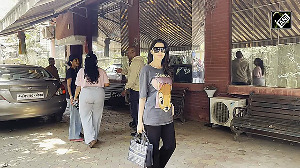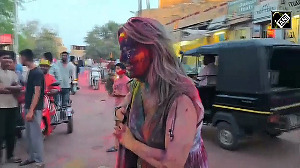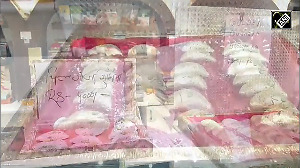The way things are going, India may have a no-limits free-for-all political contest rather than a three-horse race. Parties are approaching one another across the dividing lines of alliances, breaching conventional rules of the political game. J Jayalalithas's surprise overture to the Congress falls in that category.
The UPA isn't fighting the election as a national alliance. The Congress will go it alone but have different seat-sharing arrangements at the state level. It will project a strong all-India profile. The BJP's strategy is to fight 28 different elections in 28 states, using varying pragmatic platforms and appeals. And the Third Front is still to crystallise nationally although non-Congress-non-BJP combinations are emerging in Andhra Pradesh and Tamil Nadu.
Going by acting Finance Minister Pranab Mukherjee's interim budget, the Congress isn't clear about what it wants. Barring a large increase in the budget for the National Rural Employment Guarantee Act from Rs 16,000 to Rs 30,000 crore, it has announced no major pro-poor measures. Allocations to the Sarva Shiksha Abhiyan, the National Rural Health Mission and Drinking Water Mission have hardly risen. The NREGA raise is attributable not to greater employment provided per family, but to its extension to all the 597 rural districts.
This rise pales into insignificance beside the Rs 36,000 crore increase in military spending, or the recent bailout packages for industry, which are twice as big. Counting defence pensions, the military spending increase works out to an obscene Rs 40,000 crore. Much of this for buying new weapons, many of them irrelevant to any notion of adequate defence, but important to power projection beyond the South Asian region.
It's ludicrous to rationalise this military spending splurge as a response to the Mumbai attacks. You don't need long-range missiles, nuclear submarines, aircraft carriers, amphibian craft or 126 fighter planes to counter terrorism. The increase is part of the Congress's new muscle-flexing vis-a-vis Pakistan to counter the BJP's charge that it's 'soft' on terrorism.
But will the Congress gain by appropriating the BJP's chauvinist platform? In the past, it has always lost both credibility and votes by doing so. At any rate, the Congress has squandered a precious opportunity to give a big stimulus to the economy while creating employment and incomes for the poor. It could have done so by launching a big public works programme with labour-intensive mass housing, prevention of land erosion, construction of village roads and school buildings etc.
If the Congress has failed to generate an imaginative platform which will attract mass votes, the UPA is even worse placed to retain its present strength. In 2004, it performed spectacularly in Tamil Nadu, Andhra Pradesh, Bihar, Jharkhand, Delhi, Haryana and Himachal Pradesh, winning 129 of the 156 Lok Sabha contests there. It also put up a respectable performance in Maharashtra, Gujarat, Assam and Jammu and Kashmir.
It's highly improbable that the UPA will be able to repeat this showing. In Tamil Nadu, it has lost allies; and its mainstay, the DMK, faces anti-incumbency while the AIADMK is on the upswing. In Andhra, it faces a challenge from both the TDP-Left-Telengana Rashtra Samiti alliance and actor Chiranjeevi's new party. In Bihar, Lalu Prasad's Rashtriya Janata Party is likely to lose ground to Nitish Kumar's Janata Dal (United). In Gujarat, the UPA is unlikely to retain 12 of 26 seats, and in Assam 9 of 14 seats.
The UPA can, of course, make up these losses in small states like Kerala, Orissa and the tribal northeast, and to some extent in Rajasthan, Madhya Pradesh, J&K, and possibly, Karnataka. But these are unlikely to be bulk gains, of the kind that Uttar Pradesh can deliver.
That's exactly where the Congress has a shaky alliance with the Samajwadi Party. If this alliance works, and can present a cohesive platform which attracts a broad coalition of social forces, both parties can make gains. The Congress-SP combine could conceivably win 50 of UP's 80 seats. But the alliance isn't working. Not only was it an opportunist arrangement right from the beginning, it has turned extremely turbulent and may even collapse.
The two parties' seat-sharing talks have been stormy. The SP is loath to concede more than 15 seats to the Congress. The Congress won't accept that. Worse, there's bad blood between them because of the revival of the disproportionate assets case against party chief Mulayam Singh Yadav, which the SP blames on the Central Bureau of Investigation and the Congress. The SP has aligned itself with former BJP Chief Minister Kalyan Singh although he was deeply involved in the conspiracy to demolish the Babri mosque. The Congress resents that.
Meanwhile, Sharad Pawar's Nationalist Congress Party is openly exploring other options, including an arrangement with the SP, and an understanding with the Shiv Sena that it would support Pawar's candidature for the prime minister's post.
Pawar is in some ways an unguided missile. He's in a hurry to become prime minister -- not on the strength of his own party, but through convoluted alliances with others who are against the Congress For instance, he might try to build a an independent relationship with Jayalalithaa and other regional parties, including some that have been part of the NDA.
Pawar is likely to drift away from the UPA if the Congress does not accommodate his demands in Maharashtra, to which the NCP's base is largely confined. In the past, he has supported Shiv Sena-BJP candidates and has a good equation with both Bal and Raj Thackeray, whose Maharashtra Navnirman Sena he's believed to have covertly backed.
Under the circumstances, it's hard to believe that the UPA's seat tally could go much beyond the 200 to 230 range even if the Congress's alliance with the SP works out, and the party's major allies recoup their losses. This still won't be enough to form the government -- unlike in 2004, when the UPA had the support of the Left's 62 MPs.
What of the NDA? It too is poorly placed to gain from the UPA's stagnation or loss. The BJP is confident of winning only in Gujarat, and probably Madhya Pradesh. It's in decline in the western and central states, barring Gujarat, which contribute 40 percent-plus of all its Lok Sabha MPs.
Remarkably, no party is wooing the BJP. It has no positive programme with a broad appeal. Its 'nation-in-danger-from-terrorism-Muslims-Pakistan' platform isn't selling. Nor does it have economic policies or a social vision that will win support outside the upper-caste and upper-class urban elite.
The BJP cannot possibly replicate its winning alliance strategy of 1999. From a total of 24 parties, the NDA is now down to just seven, of whom only the JD-U, Akali Dal and Biju Janata Dal are sizeable. The rest are too small and unreliable to matter.
Nitish Kumar has always been uneasy about the BJP's Hindu-communal orientation. He distanced himself from it on the Hindutva terror network and on draconian anti-terrorist laws. He may be open to other arrangements in case the NDA shrinks in size. Even if the BJP improves its own score of 138 seats, the NDA's tally is unlikely to cross the 200-seat mark
That leaves the Bahujan Samaj Party, on the one hand, and the embryo of a Third Front, on the other. Despite its impressive record of gaining more votes and seats in election after election, the BSP cannot reproduce the UP model in other states. UP is unique in that it has the highest proportion of upper castes in the population (over 20 percent), and numerous Dalits (17 percent), besides Muslims (19 percent).
In UP, the BSP coalesced the first two groups into a bloc and got some support from the third to produce a victory. This cannot happen in other states because the Dalits aren't numerous enough, nor are the upper castes open to such alliances. The BSP's votes won't easily translate into seats. It would be a surprise if its national tally crosses 45 to 50.
The Third Front is unlikely to be able to make a bid for power even assuming it crystallises properly, with a coherent platform. The BSP has already deserted it. The Left parties are likely to suffer erosion in West Bengal and Kerala, and less severely in Tamil Nadu and Andhra. Even if many non-Congress-non-BJP parties do well regionally, the Third Front can't attract them because some of them are already aligned with the Congress or the BJP.
One thing is clear. India must await a radical restructuring of party programmes and strategies -- based on closer alignment with the people's real needs and with progressive social movements -- before it has less opportunistic, rules-free and fragmented politics.






 © 2025
© 2025